Dragging Core2Duo into 2013: Time for an Upgrade?
by Ian Cutress on January 15, 2013 12:30 PM EST- Posted in
- CPUs
As any ‘family source of computer information’ will testify, every so often a family member will want an upgrade. Over the final few months of 2012, I did this with my brother’s machine, fitting him out with a Sandy Bridge CPU, an SSD and a good GPU to tackle the newly released Borderlands 2 with, all for free. The only problem he really had up until that point was a dismal FPS in RuneScape.
The system he had been using for the two years previous was an old hand-me-down I had sold him – a Core2Duo E6400 with 2x2 GB of DDR2-800 and a pair of Radeon HD4670s in Crossfire. While he loves his new system with double the cores, a better GPU and an SSD, I wondered how much of an upgrade it had really been.
I have gone through many upgrade philosophies over the decade. My current one to friends and family that ask about upgrades is that if they are happy installing new components. then upgrade each component to one of the best in its class one at a time, rather than at an overall mediocre setup, as much as budget allows. This tends towards outfitting a system with a great SSD, then a GPU, PSU, and finally a motherboard/CPU/memory upgrade with one of those being great. Over time the other two of that trio also get upgraded, and the cycle repeats. Old parts are sold and some cost is recouped in the process, but at least some of the hardware is always on the cutting edge, rather than a middling computer shop off-the-shelf system that could be full of bloatware and dust.
As a result of upgrading my brother's computer, I ended up with his old CPU/motherboard/memory combo, full of dust, sitting on top of one of my many piles of boxes. I decided to pick it up and run the system with a top range GPU and an SSD through my normal benchmarking suite to see how it faired to the likes of the latest FM2 Trinity and Intel offerings, both at stock and with a reasonable overclock. Certain results piqued my interest, but as for normal web browsing and such it still feels as tight as a drum.
The test setup is as follows:
Core2Duo E6400 – 2 cores, 2.13 GHz stock
2x2 GB OCZ DDR2 PC8500 5-6-6
MSI i975X Platinum PowerUp Edition (supports up to PCIe 1.1)
Windows 7 64-bit
AMD Catalyst 12.3 + NVIDIA 296.10 WHQL (for consistency between older results)
My recent testing procedure in motherboard reviews pairs the motherboard with an SSD and a HD7970/GTX580, and given my upgrading philosophy above, I went with these for comparable results. The other systems in the results used DDR3 memory in the range of 1600 C9 for the i3-3225 to 2400 C9 for the i7-3770K.
The Core2Duo system was tested at stock (2.13 GHz and DDR2-533 5-5-5) and with a mild overclock (2.8 GHz and DDR2-700 5-5-6).
Gaming Benchmarks
Games were tested at 2560x1440 (another ‘throw money at a single upgrade at a time’ possibility) with all the eye candy turned up, and results were taken as the average of four runs.
Metro2033
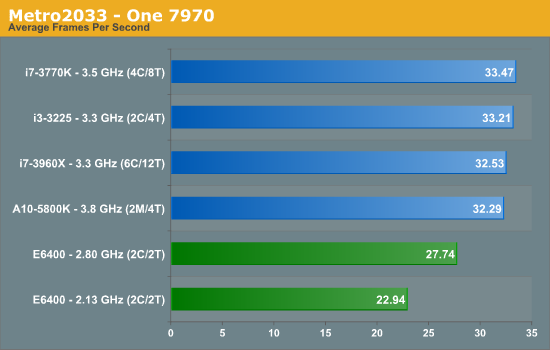
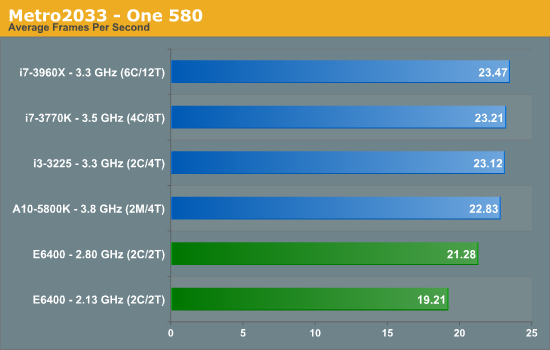
While an admirable effort by the E6400, and overclocking helps a little, the newer systems get that edge. Interestingly the difference is not that much, with an overclocked E6400 being within 1 FPS of an A10-5800K at this resolution and settings while using a 580.
Dirt3
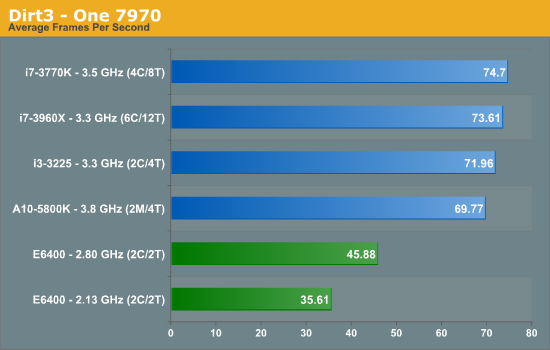

The bump by the overclock makes Dirt3 more playable, but it still lags behind the newer systems.
Computational Benchmarks
3D Movement Algorithm Test
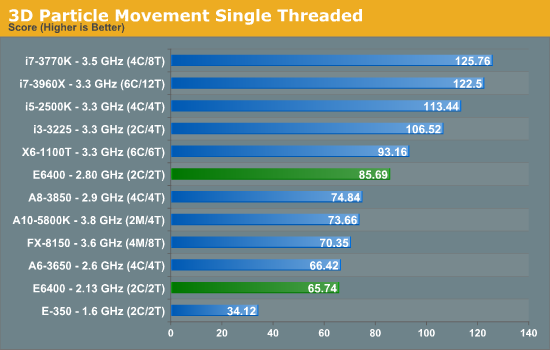
This is where it starts to get interesting. At stock the E6400 lags at the bottom but within reach of an FX-8150 4.2 GHz , but with an overclock the E6400 at 2.8 GHz easily beats the Trinity-based A10-5800K at 4.2 GHz. Part of this can be attributed to the way the Bulldozer/Piledriver CPUs deal with floating point calculations, but it is incredible that a July 2006 processor can beat an October 2012 model. One could argue that a mild bump on the A10-5800K would put it over the edge, but in our overclocking of that chip anything above 4.5 GHz was quite tough (we perhaps got a bad sample to OC).
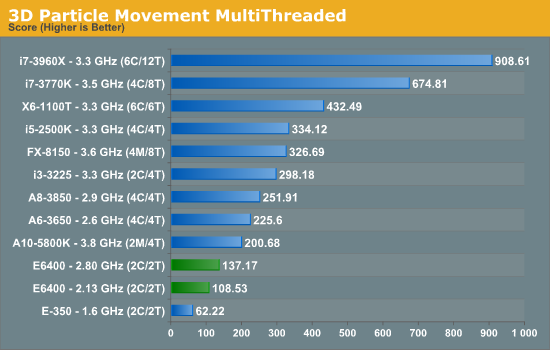
Of course the situation changes when we hit the multithreaded benchmark, with the two cores of the E6400 holding it back. However, if we were using a quad core Q6600, stock CPU performance would be on par with the A10-5800K in an FP workload, although the Q6600 would have four FP units to calculate with and the A10-5800K only has two (as well as the iGPU).
WinRAR x64 3.93 - link

In a variable threaded workload, the DDR2 equipped E6400 is easily outpaced by any modern processor using DDR3.
FastStone Image Viewer 4.2 - link
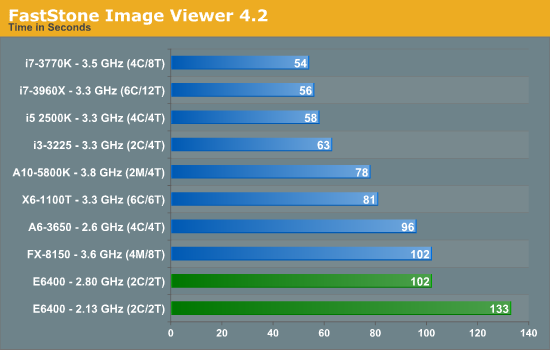
Despite FastStone being single threaded, the increased IPC of the later generations usually brings home the bacon - the only difference being the Bulldozer based FX-8150, which is on par with the E6400.
Xilisoft Video Converter
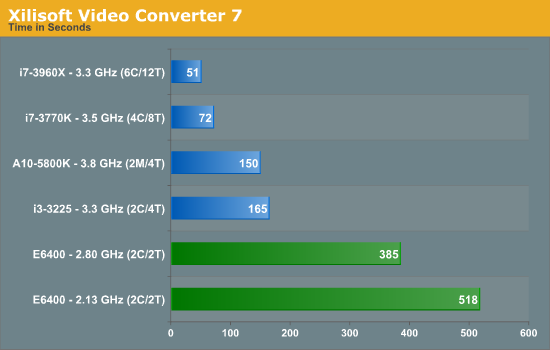
Similarly with XVC, more threads and INT workloads win the day.
x264 HD Benchmark
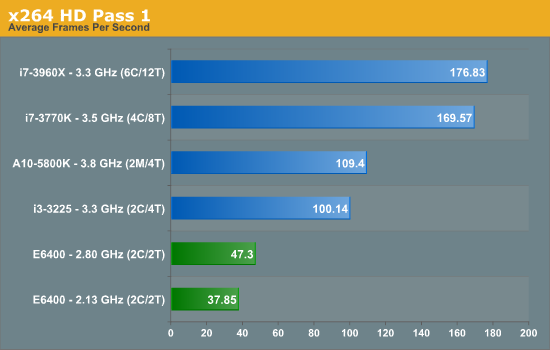
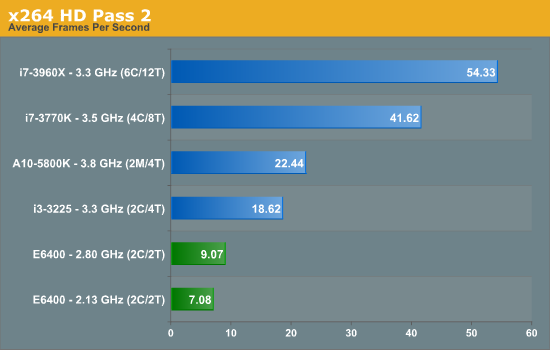
Conclusions
When I start a test session like this, my first test is usually 3DPM in single thread mode. When I got that startling result, I clearly had to dig deeper, but the conclusion produced by the rest of the results is clear. In terms of actual throughput benchmarks, the E6400 is comparatively slow to all the modern home computer processors, either limited by cores or by memory.
This was going to be obvious from the start.
In the sole benchmark which does not rely on memory or thread scheduling and is purely floating point based the E6400 gives a surprise result, but nothing more. In our limited gaming tests the E6400 copes well at 2560x1440, with that slight overclock making Dirt3 more playable.
But the end result is that if everything else is upgraded, and the performance boost is cost effective, even a move to an i3-3225 or A10-5800K will yield real world tangible benefits, alongside all the modern advances in motherboard features (USB 3.0, SATA 6 Gbps, mSATA, Thunderbolt, UEFI, PCIe 2.0/3.0, Audio, Network). There are also significant power savings to be had with modern architectures.
My brother enjoys playing his games at a more reasonable frame rate now, and he says normal usage has sped up by a bit, making watching video streams a little smoother if anything. The only question is where Haswell will come in to this, and is a question I look forward to answering.


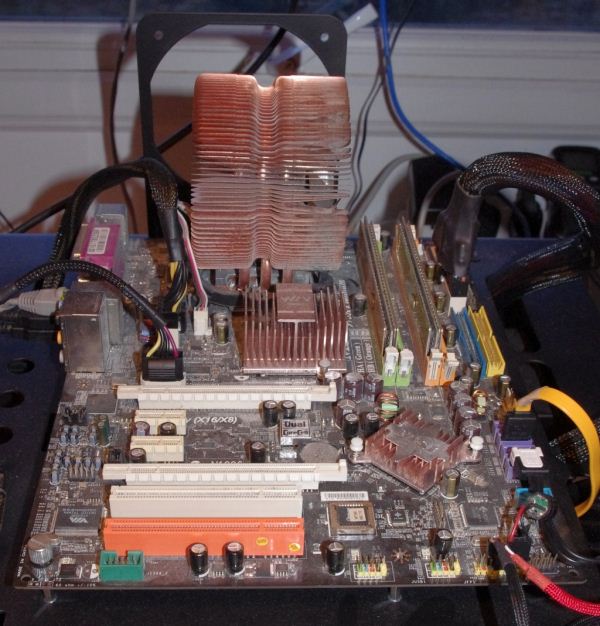








136 Comments
View All Comments
MonkeyPaw - Tuesday, January 15, 2013 - link
You can get FM2 in mITX. Not many choices, but they do exist.When talking low tech in 2013, my brother still uses the desktop I built him back in 2007 as his sole household PC. It's a single core S754 2.0ghz A64 running the classic nVidia 6100 IGP. I asked him if he wanted me to upgrade it, and he said not yet. :p
Hubb1e - Tuesday, January 15, 2013 - link
he must not click on the HD tab for youtube video. I have a similar setup at my office for when I forget my laptop. It's a S754 at 2.4ghz and AMD 9600pro and it feels ok on the web but falls over with video. Putting a real video card in it would fix mine but it's AG. The nvidia 6100 is PCI-e so you could actually help him a lot by getting a used 3450 video card for $10 online. I bet that system would last for several more years if it had video accelerationkyuu - Tuesday, January 15, 2013 - link
Eh? Trinity *did* enhance the A-series computationally as compared to Llano. It wasn't enough to catch Intel (not that anyone seriously expected it would be), but progress is certainly being made, and the Piledriver cores are a good step up from Bulldozer cores.I don't think AMD needs to equal Intel's CPU prowess in order to stay relevant. They just need to leverage their GPU advantage, which is what they're doing. When using a dGPU, there's no reason to get an AMD CPU. When using an iGPU, there's no reason to get an Intel CPU, IMO, unless all you need is enough GPU to animate UI elements. Although, Intel's GPU in the mobile space are still struggling even with that, Haswell notwithstanding.
If Haswell is all its hyped up to be (which I don't think it will be), then AMD may be in trouble if they aren't able to enhance their APU offerings to surpass it in graphics prowess fairly quickly.
CeriseCogburn - Tuesday, January 15, 2013 - link
Thanks for the article, I object to the screen resolution of 2560x1440 on the two gaming benchmarks.Is your brother sporting a $1000+ screen ?
Do you think that people with a core2 generally are ?
Your pci-e was only 1.1, there's an awful lot of pci-e 2.0 core2 out there - and higher than E6400.
So the gaming tests were important but useless due to resolution.
OC'ing the cpu was useful, but brought it to a bare minimum, as a lower clocked core2 would be an easy $40 upgrade to say E5700 or something like that, or a $49 E8400 w/6mb cache and a 3600mhz easy potential.
I find the whole idea great, but dropping in a decent cheap cpu and gaming at 1650x or 1920x would have done the article proud for people here IMO.
No one with a core2 gives a darn about the Computational benchmarks.
frumply - Tuesday, January 15, 2013 - link
You can't find C2D chips unless you hop onto ebay nowadays, which makes this sort of 'quick' upgrade more difficult than it was just a few years ago. I agree that this, and upping RAM to as close as 4GB as possible (a lot of people with earlier c2d systems have 1-2gb) is a much more realistic, painless procedure.IanCutress - Tuesday, January 15, 2013 - link
The cheap Korean panels are less than $400. At this resolution and settings, any CPU driven calculations can be a bottleneck. It also helps that all the other results I have for other CPUs were done at that resolution and those settings, otherwise this quick test for a mini article would have run into a couple of weeks of testing, rather than a day.As for PCIe, it was just the board taken out of an essentially random system, but happened to be the one my brother was using. He has a dual screen setup at home, often running a video/audio stream on one while playing RuneScape almost full-screen on the other. We can always argue 'why didn't you test XYZ', but the truth of the matter is this is what I had to test.
If I didn't upgrade his machine, or didn't have the capacity to, then a motherboard or CPU swap would indeed be on the cards if he couldn't afford a full system. As you note, there are some cheap and cheerful prices to be had for s775, although a jump to Sandy Bridge could be as little as $125 new.
Ian
Folterknecht - Tuesday, January 15, 2013 - link
The PCIe 1.0 Board probably bottlenecked the both GPUs at least in some benchmarks.I would really like to see a follow up on this with a P45-board (PCIe 2.0) and a Q9550 or something similar.
extide - Tuesday, January 15, 2013 - link
The point was to compare the system using the SAME benchmarks used on the modern systems, that way he could have numbers to compare to. It's not like he actually benched all of those machines for this article, he just benched the core2 system, and used pre-existing benchmarks to compare against.silverblue - Tuesday, January 15, 2013 - link
It's not a bad point to make though, however as mentioned, the hardware has to be available. Perhaps for a follow-up article?LauRoman - Tuesday, January 15, 2013 - link
I still use a Core 2 Quad and may be using it until it melts.